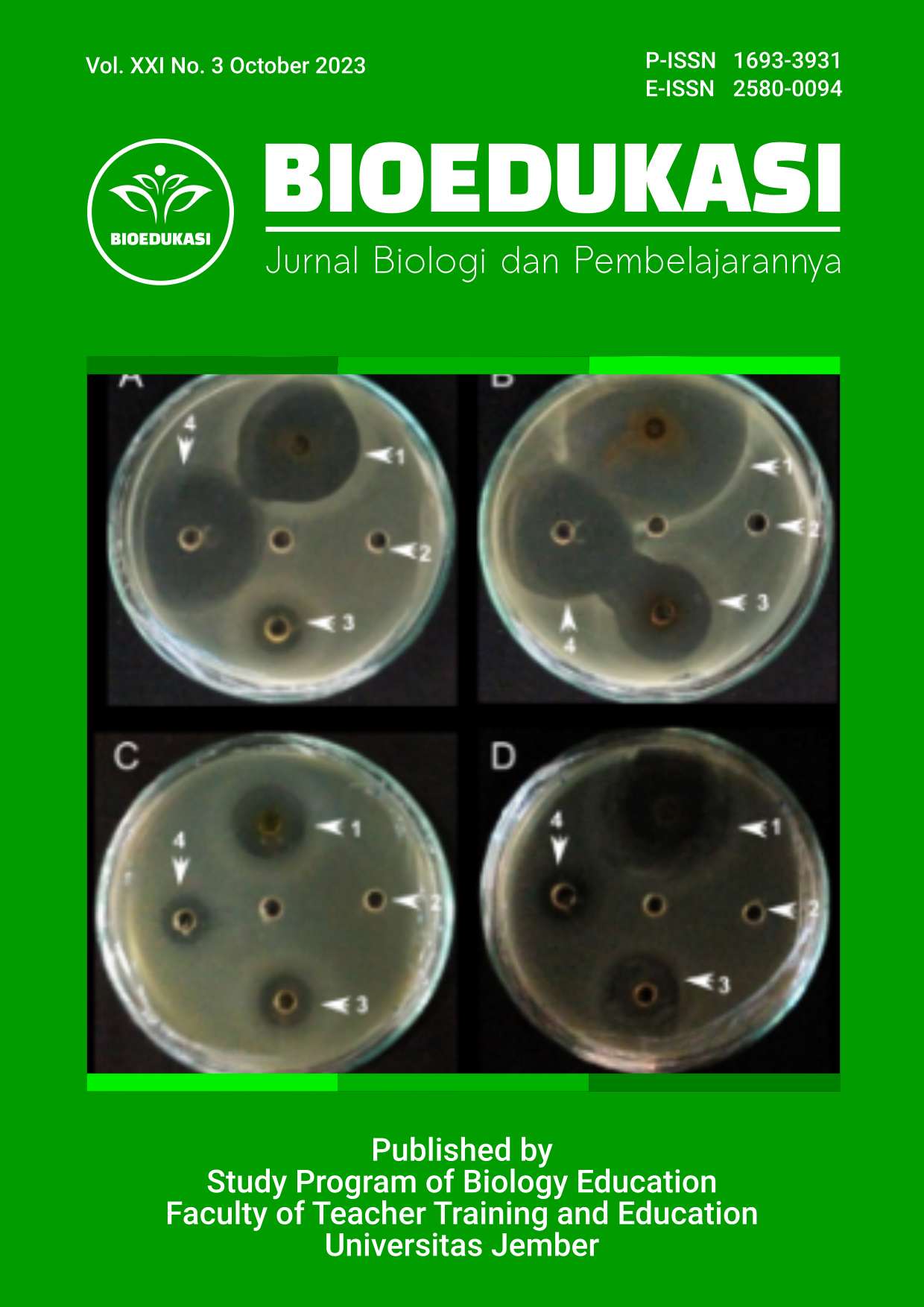Analysis of the Quality of Ecoenzymes and Their Effect on the Growth of Mustard Greens (Brassica juncea L.)
DOI:
https://doi.org/10.19184/bioedu.v21i3.39565Keywords:
Ecoenzyme, Growth, Liquid Organic Fertilizer, MustardAbstract
Making ecoenzymes is one of the solutions to reduce the quantity of organic waste which has been increasing lately. Ecoenzymes are liquid extract products produced from fermentation of vegetable and fruit residues with brown sugar or molasses as a substrate. Types of vegetables and fruits used as ecoenzyme ingredients can affect the levels of minerals or nutrients contained in ecoenzymes. Information about this will be an important consideration in the process of making ecoenzymes as Liquid Organic Fertilizer. This study aims to determine the quality of ecoenzymes from fruit and vegetable combinations, and to determine the effect of ecoenzymes on the periodic growth of mustard plants. Analysis of the quality of ecoenzymes was carried out through physical and chemical observations using laboratory tests, while analysis of the effect of ecoenzymes was carried out quantitatively by statistical tests using the SPSS application. The results showed that the ecoenzyme liquid contains macro nutrients (N, P, and K), and has a significant effect on the growth parameters of mustard plants.
Downloads
References
Gultom, F., Hernawaty, Herianto, B., dan Selamat, K. (2022). Pemanfaatan Pupuk Ekoenzim dalam Meningkatkan Pertumbuhan dan Produksi Tanaman Bawang Merah (Allium cepa L.). Jurnal Darma Agung, 30(1), 142–159. https://doi.org/10.46930/ojsuda.v30i1.1433.
Hariyanto. (2014). Pengelolaan Sampah di Kota Semarang Untuk Menuju Kota Bersih. Jurnal Geografi : Media Informasi Pengembangan Dan Profesi Kegeografian, 11(2), 237–246.
Hermansyah, D., Markus, P., dan Nugrahini, S. W. (2021). Analisis Trend dan Prediksi Produksi dan Konsumsi Komoditas Sayuran Sawi (Brassica Juncea L) di Indonesia Tahun 2020 s/d 2029. Jurnal Ilmiah Sosio Agribis, 21(2), 34–46. https://doi.org/10.30742/jisa21220211383.
Kepmen Pertanian. (2019). Persyaratan Teknis Minimal Pupuk Organik, Pupuk Hayati, dan Pembenah Tanah. In Pub. L. No. 261/ KPTS/ SR. 310//M/4/2019 (2019). (pp. 1–18). http://psp.pertanian.go.id/index.php/page/publikasi/418.
Lumbanraja, S. N., Budianta, D., dan Rohim, A. M. (2021). Pengaruh Ecoenzyme dan SP-36 terhadap Beberapa Sifat Kimia Tanah dan Pertumbuhan Tanaman Sawi (Brassica juncea L.) pada Ultisol. Agri Peat, 23(1), 1–11. https://dlh.cimahikota.go.id/article/detail?id=21.
Poompanvong, R., Joean, O., dan Joni, O. (2020). Pembuatan Eco-Enzyme. In Eco enzyme nusantara (pp. 1–62).
Rahmawati, I. D., Kristanti, I. P., dan Anton, M. (2018). Pengaruh Konsentrasi Pupuk P Terhadap Tinggi dan Panjang Akar Tagetes erecta L. (Marigold) Terinfeksi Mikoriza yang Ditanam Secara Hidroponik. Jurnal Sains Dan Seni ITS, 7(2), 2337–3520. https://doi.org/10.12962/j23373520.v7i2.37048.
Rasit, N., Lim Hwe Fern, Wan, A. W. A. K. G. (2019). Production and Characterization of Eco Enzyme Produced from Tomato and Orange Wastes And Its Infulence on The Aquaculture Sludge. International Journal of Civil Engineering and Technology (IJCIET), 10(3), 967–980.
Rijal, M., Surati, Israwati, A., Azwar, A., Abu, B. L., Abd. Sofyan, Y., dan Nafsia, T. (2021). Eco-Enzyme dari Limbah Tanaman Maluku. In Eco-Enzyme Dari Limbah Tanaman Maluku. http://repository.iainambon.ac.id/2308/1/BUKU ECO-ENZYME.pdf.
Rochyani, N., R. L. Utpalasari, dan Inka, D. (2020). Analisis Hasil Konversi Eco Enzyme menggunakan Nenas (Ananas comosus) dan Pepaya (Carica papaya L.). Jurnal Redoks, 5(2), 135–140. https://doi.org/10.31851/redoks.v5i2.5060.
Samriti, Sajal, S., and Arti, A. (2019). Garbage Enzyme: A study on Compositional Analysis of Kitchen Waste Ferments. The Pharma Innovation, 8(4), 1193–1197. https://www.thepharmajournal.com/archives/2019/vol8issue4/PartR/8-7-10-596.pdf.
Sarif, P., Abd. Hadid, & Imam, W. (2015). Pertumbuhan dan HasilTanaman Sawi (Brassica juncea L.) Akibat Pemberian Berbagai Dosis Pupuk Urea. Jurnal Agrotekbis, 3(5), 585–591. https://media.neliti.com/media/publications/249324-pertumbuhan-dan-hasil-tanaman-sawi-brass-5e12b59f.pdf.
Supriyani, & Astuti, Andari P. A., Endang, T. W. M. (2020). Pengaruh Variasi Gula terhadap Produksi Ekoenzim menggunakan Limbah Buah dan Sayur. Seminar Nasional Edusainstek, 470–479.
Viza, R. Y. (2022). Uji Organoleptik Eco-Enzyme dari Limbah Kulit Buah. 5(1), 24–30.
Widowati, H. (2019). Komposisi Sampah di Indonesia Didominasi Sampah Organik. In Databoks. databoks.katadata.co.id/datapublish/2019/11/01/komposisi-sampah-di-indonesia-didominasi-sampah-organik.
Wiryono, B., Sugiarta, S., Muliatiningsih, M., & Suhairin, S. (2021). Efektivitas Pemanfaatan Eco Enzyme untuk Meningkatkan Pertumbuhan Tanaman Sawi dengan Sistem Hidroponik DFT. Prosiding Seminar Nasional Pertanian, 2(1), 63–68. https://journal.ummat.ac.id/index.php/SEMNASPUMMAT/article/view/6798.




